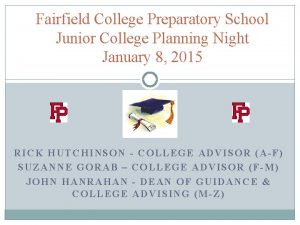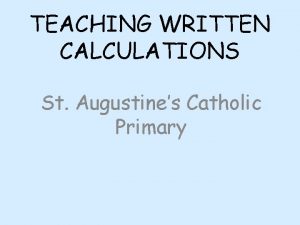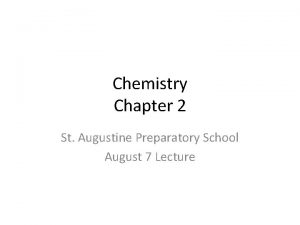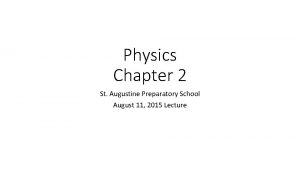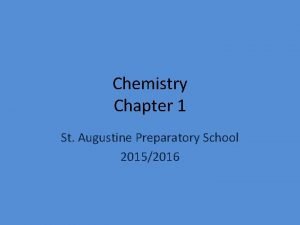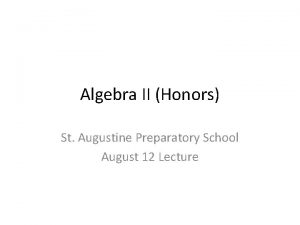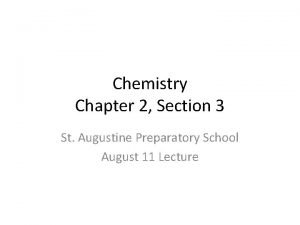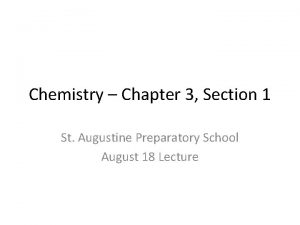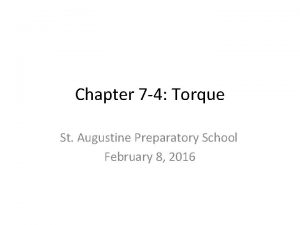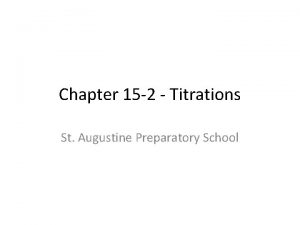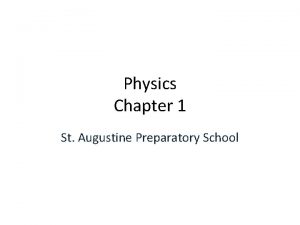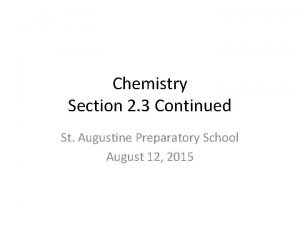Chemistry Chapter 1 St Augustine Preparatory School August














- Slides: 14

Chemistry Chapter 1 St. Augustine Preparatory School August 6, 2015 lecture

What we covered last class • Atoms versus Elements • Diatomic elements, as well as phosphorous and sulfur • Extensive and Intensive Properties • Physical and Chemical changes

Solids, Liquids, and Gases Pick the correct term for the sentence: Solids: Have a definite/indefinite volume and a definite/indefinite shape Liquids: Have a definite/indefinite volume and a definite/indefinite shape Gases: Have a definite/indefinite volume and a definite/indefinite shape

Solids, Liquids, and Gases Pick the correct term for the sentence: Solids: Have a definite volume and a definite shape Liquids: Have a definite volume and an indefinite shape Gases: Have an indefinite volume and an indefinite shape

Further classifying matter • We can classify matter as either a pure substance or a mixture. • Pure substances: can be either compounds or elements that have definite chemical and physical properties. (ex. compound: pure H 2 O, element: pure copper). - Every sample of a pure substance will be the same!

Mixtures • A mixture is a blend of two or more types of matter. • Homogeneous mixtures have the same proportion of components throughout - (salt water, orange juice without pulp, liquid laundry detergent) • Heterogeneous mixtures are not uniform throughout – Each sample you take could be different - (sand in water, bowl of fruit loops, soil, orange juice with pulp)

Classify the following as either pure/mixture and then either element, compound, heterogen. or homogen. 1) 2) 3) 4) 5) 6) 7) Gold Sand salt Lake water Salt water Iron Brass Iron Rust (Fe 2 O 3)

Classify the following as either pure/mixture and then either element, compound, heterogen. or homogen. 1) 2) 3) 4) 5) 6) 7) Gold Pure, element Sand salt Mixture, heterogeneous Lake water Mixture, heterogeneous Salt water Mixture, homogeneous Iron Pure, element Brass Mixture, homogeneous Iron Rust (Fe 2 O 3) Pure, compound

Self-Study Read pages 17, 18, and 19 You should be able to answer the following: a) What are groups/families? b) What are periods? c) Do groups or periods share similar qualities? d) Where are metals located on the periodic table and what characteristics do they have? e) Where are non-metals and metalloids located? What characteristics do they have?

Converting units • In chemistry, we often have to convert from m. L to L, g to kg, mg to kg, etc. • The prefix “milli” represents a factor of 10 -3 • The prefix “kilo” represents a factor of 103 • Grams, liters, meters, etc. are the base that these prefixes work on. This means that 1000 m. L = 1. 0 L, 1000 mg = 1. 0 g, 1000 g = 1. 0 kg, and 1 000 mg = 1 kg

Converting Units • When converting units, we use a unit cancelation method. • Example 1: Convert 562 mg to grams • Example 2: Convert 0. 032 k. L to m. L

Convert the following (properly) *Show your work 1) 2) 3) 4) 5) 32. 3 m. L to L 125. 6 mg to g 2. 98 x 107 mg to kg 0. 003 kg to g 123. 89 m. L to k. L

Chapter 1 Review • Page 23 #9, 11, 15, 16, 18, 27, 29 • Page 25 #2, 4, 7, 8

 St augustine school cambridge
St augustine school cambridge St augustine school cambridge
St augustine school cambridge Lutz prep lottery
Lutz prep lottery James weldon johnson college preparatory middle school
James weldon johnson college preparatory middle school Akron preparatory school
Akron preparatory school Northdene prep
Northdene prep Fairfield college preparatory school
Fairfield college preparatory school Aot 1
Aot 1 St augustine's rc church
St augustine's rc church Windfinder st augustine
Windfinder st augustine Mysterion sacrament
Mysterion sacrament Wo wird einst des wandermüden letzte ruhestätte sein
Wo wird einst des wandermüden letzte ruhestätte sein St augustine deaf history
St augustine deaf history St augustine
St augustine Shon augustine
Shon augustine






